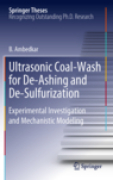
Ultrasonic coal-wash for de-ashing and de-sulfurization: experimental investigation and mechanistic modeling
Ambedkar, B.
This study focuses on the physical aspects of ultrasonic de-ashing and de-sulfurization, such as cavitation, streaming and their combined effects. AmbedkarBalraj proposes an ultrasound-assisted coal particle breakage mechanism and explores aqueous and solvent-based ultrasonic techniques for de-ashing and de-sulfurization. Ambedkar designs a Taguchi L-27 fractional-factorial matrix to assess the individual effects of key process variables. In this volume he also describes process optimization and scale-up strategies. The author provides a mechanism-based model for ultrasonic reagent-based coal de-sulfurization, proposes a flow diagram for ultrasonic methods of high-throughput coal-wash and discusses the benefits of ultrasonic coal-wash. Coal will continue to be a majorfuel source for the foreseeable future and this study helps improve its use by minimising ash and sulfur impurities. Nominated by the Indian Institute of Technology Madras, India as an outstanding PhD thesis. Detailed description of physical aspects of ultrasonic de-ashing and desulfurization. Exploration of aqueous and solvent-based ultrasonic techniques for de-ashing and de-sulfurization INDICE: Introduction. Literature review. Assessment of fly-ash erosion potential of indian coals. Experimental studies on ultrasonic coal beneficiation.Experimental studies and mechanistic modeling of reagent-based ultrasonic coal de-sulfurization. Assessment of benefits from ultrasonic coal-wash (uscw). Summary, conclusions and recommendations.
- ISBN: 978-3-642-25016-3
- Editorial: Springer Berlin Heidelberg
- Encuadernacion: Cartoné
- Páginas: 123
- Fecha Publicación: 31/12/2011
- Nº Volúmenes: 1
- Idioma: Inglés
